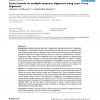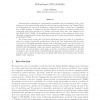653 search results - page 64 / 131 » Using common random numbers for indifference-zone selection |
JSAC
2007
13 years 8 months ago
2007
— To achieve high performance and resilience to failures, a client can make connections with multiple servers simultaneously and receive different portions of the data from each ...
BMCBI
2007
13 years 9 months ago
2007
Background: Multiple sequence alignment is fundamental. Exponential growth in computation time appears to be inevitable when an optimal alignment is required for many sequences. E...
MFCS
2007
Springer
14 years 3 months ago
2007
Springer
A framework for analyzing the computational capabilities and the limitations of the evolutionary process of random change guided by selection was recently introduced by Valiant [V...
COLT
1992
Springer
14 years 1 months ago
1992
Springer
We consider learning in situations where the function used to classify examples may switch back and forth between a small number of different concepts during the course of learnin...
NIPS
2004
13 years 10 months ago
2004
We study a number of open issues in spectral clustering: (i) Selecting the appropriate scale of analysis, (ii) Handling multi-scale data, (iii) Clustering with irregular backgroun...


